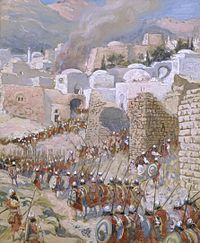Joshua fit de battle ob Jerico/
An’ de walls come tumblin’ down.
—Black spiritual
Yahweh’s Commander
Jericho stood on a high hill. The city was oblong and covered nine acres. Its compound outer wall was six times the height of a man. Its massive inner wall stood further up on an inclined earthen embankment covered with plaster. The city was impregnable.
As Joshua stood beneath it, surveying its defenses, something in the shadow caught his eye. He looked up and saw a warrior with a sword in hand. Joshua immediately spoke in challenge: “Are you for us, or for our enemies?”
The warrior said, “No.”
 Logic books describe the fallacy of the false dilemma. Republican or Democrat? Conservative or liberal? Nuclear proliferation or total disarmament? McDonald’s or Burger King? Often there’s a third choice. Sometimes that choice, once it becomes clear, recasts the whole debate. It reveals all the other choices to be minor variations on the same theme.
Logic books describe the fallacy of the false dilemma. Republican or Democrat? Conservative or liberal? Nuclear proliferation or total disarmament? McDonald’s or Burger King? Often there’s a third choice. Sometimes that choice, once it becomes clear, recasts the whole debate. It reveals all the other choices to be minor variations on the same theme.
So it was at Jericho. Joshua’s question presented only two choices: loyalty to Israel or to Jericho. But an answer in either direction would be a commitment to a merely human and temporal military force. The mysterious warrior upset that nice little dilemma by introducing himself: “No, but as the commander of the armies of Yahweh have I now come.” Joshua fell on his face before the Angel of the LORD and waited for instructions.
Worship as Warfare
Israel entered the Promise Land by miracle. God parted the river Jordan as He had parted the Red Sea forty years earlier. Israel passed through the divided waters on dry ground. This was baptism for a new generation (1 Cor. 10:1-2; cf. Josh. 4:23).
Israel then set up stone monuments to commemorate the crossing: twelve stones on the river bottom and twelve stones from the river stacked (or set in a circle?) at Gilgal, their encampment (Josh. 4). These were testimonies to future generations, sermons in stone of the power that God had displayed in space and time.
Israel’s next priority was circumcising the younger generation. Israel had neglected the sacrament during her years in the wilderness. Now Yahweh insisted that His people be marked with the covenant sign (Josh. 5:2ff). The mass circumcision at Gilgal was the covenantal corollary to Israel’s baptism in Jordan. Both spoke of purification and life out of death. The surgery, of course, left Israel’s warriors incapacitated in enemy territory, but obedience in matters of worship took precedence over the normal rules for self-preservation.
Israel had crossed Jordan on the tenth day of the first month. This was the beginning of Passover season, the day that Israel set aside the Passover lambs for inspection and future slaughter. The newly circumcised males recovered from their surgery in time to celebrate the festival. Passover commemorated Yahweh’s holy war against Egypt and Israel’s redemption from bondage. The Passover feast was a communion meal with Yahweh and served as a pledge of His gracious reign over Israel and the privileges that reign entailed: God was with His people.
So far everything Israel had done towards the conquest of Canaan was, in fact, worship. Much of it would have seemed utterly foolish to the military mind. But Joshua understood that the war he was about to prosecute was not like other wars. The war for Canaan was more than a just war: it was a holy war, a war that Yahweh Himself had to fight. And the first step was the conquest of Jericho.
Yahweh’s Strategy
Jericho stood at the ascent to Jerusalem as the gateway to the Promised Land. And yet Jericho was obviously impregnable. No human force could breach its wall. A siege was impractical and dangerous. The spring harvest had already been taken in. Jericho had grain enough to withstand a very long siege (cf. 5:11). If Israel sat still and did nothing, she invited an onslaught from the surrounding Canaanite tribes. On the plain of Jordan, Israel would be a sitting duck.
As Joshua surveyed the city, he saw how impossible this battle was. But Joshua knew that he was fighting Yahweh’s war; and now Yahweh stood before him as the Angel of the Covenant. With this Angel, anything was possible.
The divine Commander handed Joshua an amazing strategy (Josh. 6). The priests of the LORD would carry the Ark of the Covenant in a liturgical procession around the city of Jericho. The Ark was God’s throne and footstool. It symbolized Yahweh’s presence in the midst of His people. Seven additional priests would go before the Ark and blow trumpets made of rams’ horns. Before those priests, Israel’s armies would march in respectful silence. They were all to do this each day for seven days. On the seventh day, apparently the Sabbath, they were to march around the city seven times. When they completed the last circuit, the priests were to blow a loud blast on the trumpets and the people were to give a shout. Both the trumpet blast and the shout were acts of worship (Ps. 32:11; 47:5). Yahweh promised that the walls of Jericho would fall in response to Israel’s worship.
Once it fell, the whole city was to be placed under the ban (herem); that is, it was to be surrendered wholly to God as the first fruits of the conquest. Israel was to destroy every living thing in Jericho and burn the city with fire (Josh. 6:24). Only the precious metals and the artifacts of iron and brass that passed through the fire could be taken, and these went to the service of the Tabernacle, God’s house. Again, the theme was worship.
God’s people did as He had ordered. The city fell. Its upper walls collapsed and slid down to the base of the retaining wall. (Archaeologists have found the scattered bricks from the upper walls at the base of the city.) The fallen walls became ramps across which Israel’s soldiers could ascend into the open city to finish their work. Everything happened the way the Angel of the LORD said it would.
The City of Man
The story of Jericho forms part of the background for the Book of Revelation. There, as here, we find seven trumpets that reveal the Ark of the Covenant (11:15-19); we see the destruction of the great city Babylon (11:13; ch. 18); and we see that city wholly burnt with fire (17:16; 18:8). All of this is in the context of a heavenly worship service. Many commentators wrongly suppose that the fall of Babylon the Great lies at the end of history. Yet John says plainly that his prophecy concerns things that must “shortly come to pass”—that “the time is at hand” (Rev. 1:1, 3; 22:10). John’s eye was on the First Century.
The first city to stand in the way of Christ’s kingdom was apostate Jerusalem (Gal. 4:25, 29; 1 Thes. 2:14-16; Rev. 11:8). Until that “great City” fell, the true nature of the Church was obscured by the shadows of the Old Covenant order. The fall of Jerusalem in AD 70 brought an end to Jewish persecution and publicly heralded the coming of Christ’s universal kingdom (Rev. 11:15; 19:1-9). As with Jericho, the fall of the great city marked the beginning of the holy campaign, not its end.
But in every age the City of Man makes its appearance in one form or another: a New Atlantis, a Great Society, a thousand-year Reich, a People’s Republic, Bush One’s dream of a New World Order. The City of Man offers paradise on earth, but always by purely human means: education, politics, science, or technology. For the last three hundred years the dream has been trumpeted in increasingly secular terms, but it has remained religious to the core for all of that. Man is ultimate. Man will remake man. The world will be one and resistance is futile. That’s very much the world we live in today.
Meanwhile, God’s people are pilgrims on their way to Zion. Or to switch metaphors, they are slowly building in the suburbs of the New Jerusalem. For though we have here “no continuing city,” we nevertheless have already come to “Mount Zion, and unto the city of the living God the heavenly Jerusalem” (Heb. 13:14; 12:22). The world to come has invaded the present world order, and God’s people live in Zion by faith.
Conclusion
If the Church is to prosper in this eschatological “now,” this “already but not yet,” she must understand that her warfare, like Israel’s, is holy warfare (2 Cor. 10:4). Christ is the Angel of the LORD who rides through history slaying the nations with the sword of His mouth (Rev. 19). The Church must be actively obedient, but the battle is His. Christians have always struggled with the “either-or” polarization here. If it’s God’s battle, I’ll make it an abstraction and watch. If it’s my battle, God should get out of the way and let me do my thing. But here’s the thing: We’re called to a different battle plan with an amazing field manual. The Bible. As the Church makes the proclamation of the gospel and gospel-centered worship her focus and priority, Christ will subdue His enemies in His own good time. His kingdom will come on earth as it is in heaven. That means giants will fall and walls will come tumbling down if we but faithfully execute the orders in our field manual.
For Further Reading:
Francis Schaeffer, Joshua and the Flow of Biblical History (Downers Grove, IL: InterVarsity Press, 1975).
Rick Wade, “The Yahweh War and the Conquest of Canaan,” Bible.org, 2010. <https://bible.org/article/yahweh-war-and-conquest-canaan>
John Piper, “The Conquest of Canaan” (November 7, 1981), <https://www.soundofgrace.com/piper81/112981m.htm>
Bryant Wood, “The Walls of Jericho,” Answers in Genesis (March 1, 1999) <https://www.answersingenesis.org/articles/cm/v21/n2/the-walls-of-jericho>
Roderick Campbell, Israel and the New Covenant (Philadelphia: Presbyterian and Reformed Publishing Company, 1954).
©2012 Off the Grid News
 Off The Grid News Better Ideas For Off The Grid Living
Off The Grid News Better Ideas For Off The Grid Living




